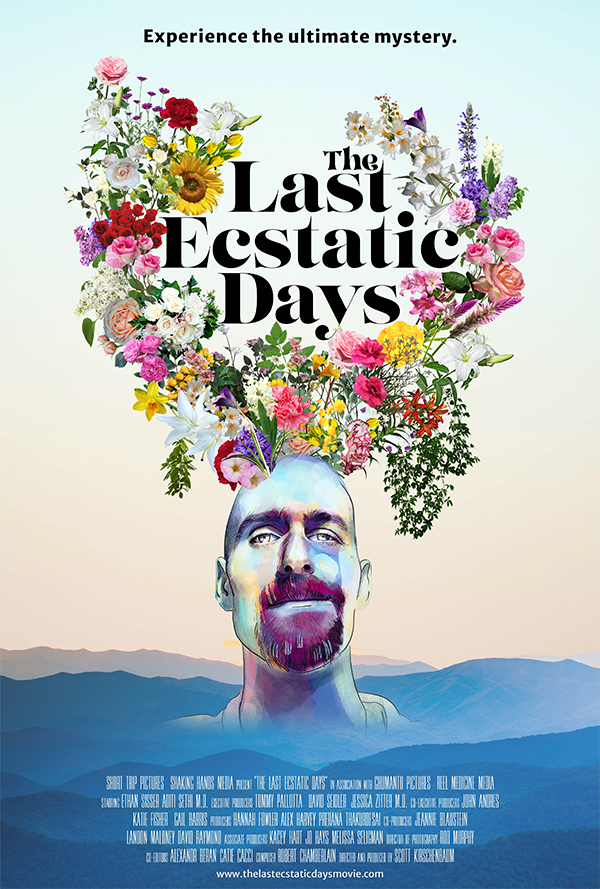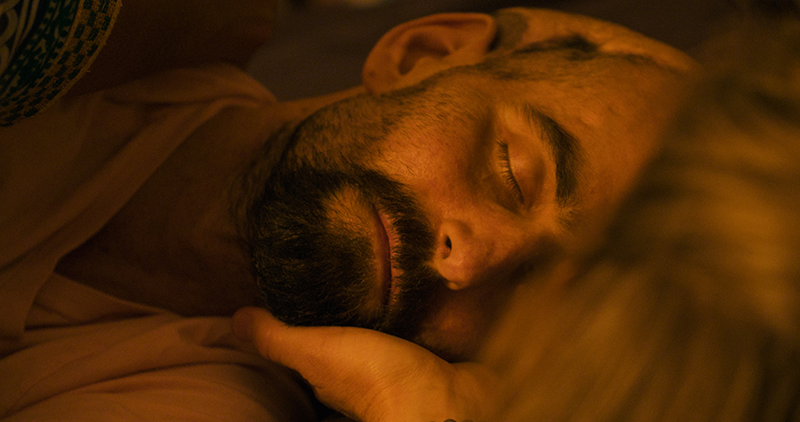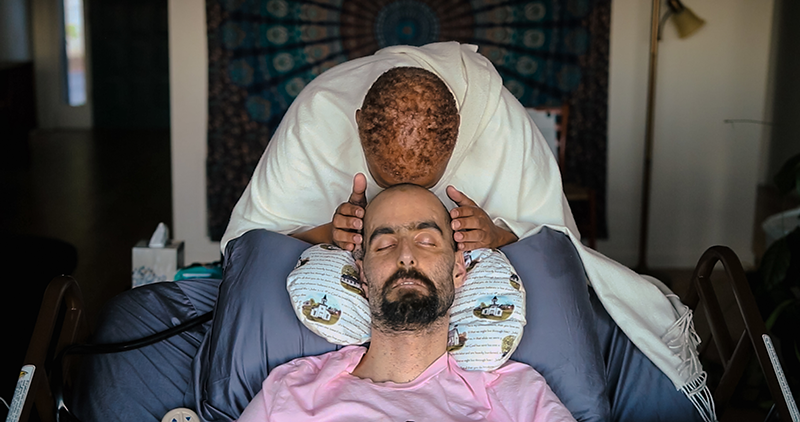Home > Resources > The Last Ecstatic Days
A Conversation With Hannah Fowler, Impact Producer of The Last Ecstatic Days
by Loren Talbot
Film Synopsis:
The film The Last Ecstatic Days follows the story of Ethan Sisser, a young man afflicted with brain cancer. He had been sitting alone in his hospital room, but when he begins live-streaming his death journey on social media, thousands of people around the world join him and celebrate his courage. Still, Ethan envisions more—to teach the world how to die. To honor his final wish of filming his death, his physician, Dr. Aditi Sethi, transports him to a quiet house in the Blue Ridge Mountains of Asheville, North Carolina. What unfolds next is a story that’s rarely glimpsed: how a community of strangers helps an unhoused man die on his own terms.
Inspired by her experience of caring for Ethan, Aditi, already a hospice doctor and death doula, founded the Center for Conscious Living and Dying in Asheville. Featured in the forthcoming The Last Ecstatic Days, Aditi is an emerging and important voice for shifting our culture’s understanding and approach to dying, death, and bereavement care.
Here, film producer Hannah Fowler shares insights into the story, the documentary and Aditi’s work. Hannah is uniquely qualified to produce this film: She’s a hospice nurse, end-of-life doula, and facilitator and educator, and she is the director of education and engagement for the Center of Conscious Living and Dying.
Who was Ethan? How did his spirit spawn this amazing film and the center?
Ethan was a seeker. Throughout his life, as far as I understand, he was committed to self-growth and introspection, and uncovering all the stones inside himself. He was a yogi and a massage teacher, and he studied many different healing modalities and shamanic work. He traveled all over the world and very much spent the latter part of his life looking inward, I think preparing for what would eventually happen. Like so many of us in life, I think Ethan’s whole life was preparing him for his last days.
Was Aditi his doctor from his original diagnosis?
She only met Ethan a few weeks before he died, right before they started filming. Ethan put out in a livestream that he was in Charlotte, North Carolina, in an inpatient hospice, and said, “I don’t want to die here. I want to film the last weeks of life when I can no longer hold the camera. And I want to die in community.” The inpatient hospice wouldn’t allow a lot of visitors. It was during COVID, and they also wouldn’t allow filming. A man named JoJo Silverman saw Ethan’s livestream and asked, “Can we transfer him to Asheville?”
Aditi transferred him from Charlotte to Asheville, and she was his admitting physician at an area hospice. She tried to get the hospice there to film to honor his wish, but they wouldn’t allow it. I think they were close to doing it and then vetoed it last minute. That sparked her desire to honor his wish in a different, creative way, because she was a fierce advocate for her patients and their wishes, and also because she was deeply moved by Ethan and his spirit. She reached out to a friend and asked, “Can we use your home and care for him there instead? You know we’ve got to get him somewhere we can accommodate his wish of dying in community and filming it.” A friend said yes. And she walked away from being his hospice doctor to become his death doula.
Is this house the same location that the Center for Conscious Living and Dying is located at today?
The center was purchased after Ethan’s death. Although the vision for community-supported end-of-life care was in Aditi’s field for years, her experience of caring for Ethan was really the catalyst to launch the center into being. Many others featured in the film, including Greg Lathrop, a traditional medicine healer and death doula, also shared this vision for over 20 years. But the timing of Ethan’s death is what catalyzed this cocreated vision into being.
What was Aditi able to provide in that space that she was unable to give—and that Ethan was unable to get—in the other spaces he was in after his diagnosis?
In the hospice setting he wasn’t allowed to have many visitors at a time because it was at the height of COVID. Additionally, Ethan wanted naturopathic and alternative modalities, which hospice doesn’t always allow for. That combined with the lack of hospice honoring his last wish to be filmed. All of those were able to be accommodated in a home setting versus inpatient.
As a former hospice nurse, I can attest to how as hospice providers we are often taught to stay within our siloed scope of practice. Meaning, doctors focus on comfort management through prescribing; often, nurses focus on administering medications and educating family, etc.—social workers, nurse aides, and spiritual care members or chaplains. In this homelike, nonmedicalized, communal setting, Aditi didn’t have to practice within the scope of being a physician. She was able to offer all of her gifts as a whole being, to another whole being, rather than siloed care. In this way, the lack of systems, the lack of fear and institutionalized approaches to end-of-life care, allowed for the focus of Ethan’s care to be more reflective of his wish, which was holistic in approach.
What do you hope the film shares?
The movie is not trying to say that we should all die like Ethan. I want to make that distinction, because it comes up for people. To me, if death is like holding up a mirror to the way we live our own lives, then this film is simply asking us to do that. It’s asking, “How do you want to live until you die? And if you could ask for what you want, because you can, what would that be?” Because most of us don’t know that we can ask that—not only on our deathbed, but throughout our whole lives, up until our last breath. So it’s really a film about breaking down the taboo and the systems that keep us trapped in fear. That is what excites me so much about this film and this movement—it’s allowing us the opportunity to step into our own voice and lead from our own compass, as Ethan did.
The Film Team
Click here to see the team behind the film. Sign up at https://www.thelastecstaticdaysmovie.com/news for news and more information.



